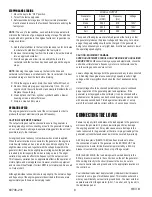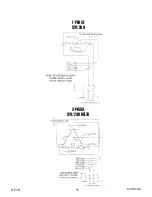
7
REV B
60706-231
to prevent severe damage caused by an insufficient amount of oil in
the crankcase. However, if the unit is repeatedly allowed to shutdown
on low oil pressure, progressive damage will be done to the engine,
shortening the engine’s life. The engine switch will remain in the “ON”
position when the unit is shutdown by the low oil pressure system.
CAUTION: EQUIPMENT DAMAGE
Allowing the engine to shutdown repeatedly on low oil level may cause
excessive wear which can be cumulative.
BATTERY INSTALLATION
You will need to connect this unit to a battery to operate it. Cables
have not been provided as length are going to vary depending on
your installation. These engines are all negative ground. The positive
battery cable must be connected to the open large terminal on the
start solenoid (This terminal may have a small 16 GA. wire on it for
the charging circuit). The negative cable should be attached to a good
ground on the engine. This is usually one of the starter mounting studs.
A twelve volt battery, rated at 300 CCA or larger is recommended for
this electric start generator set. Follow the battery manufacturer’s
recommendations for servicing and charging prior to use.
A 12 Volt battery, BCI group 26 rated at 500 CCA or larger is
recommended for this electric start engine-generator set. Follow the
battery manufacturers recommendations for servicing and charging
prior to use. Connect the battery to the electric start system using the
cables provided.
CAUTION: EQUIPMENT DAMAGE
These electric start engines are NEGATIVE GROUND. Use extreme
caution when connecting the battery. Connect the NEGATIVE battery
terminal to GROUND.
For your safety, always connect the positive battery cable to the “bat+”
terminal first. Then connect the negative battery cable to the “Bat-”
terminal. Make sure all connections are clean an tight. Reverse the
sequence when disconnecting, disconnect the negative cable first.
These engines produce enough direct current to keep the battery
charged under normal operating conditions, but were not intended to
be used as a battery charger.
WARNING: PERSONAL INJURY
Lead acid batteries produce explosive hydrogen gas when charging.
Keep sparks, flames, and burning cigarettes away from the battery.
Ventilate the area when charging or using the battery in an enclosed
space. Lead acid batteries contain sulfuric acid, which causes severe
burns. If acid contacts eyes, skin, or clothing, flush well with water. For
contact with the eyes, get immediate medical attention.
BATTERY CHARGING
Units have a small flywheel charger built into the engine flywheel
assembly for recharging the starting battery. This flywheel charger
generates a small AC current that passes through a diode assembly
to produce DC charging current of about 1 to 3 Amps. This circuit is
not designed to be used as a battery charging circuit to recharge dead
batteries.
INITIAL START UP
The throttle control on these generators is preset and locked to operate
at 3600 RPM (nominal) with no load speed set at 3690 RPM. Only
a trained service technician should be allowed to adjust this speed
setting.
NOTICE: ENGINE START LOCKOUT
This unit will not start if it is low on oil. The lubricating oil level must be
at the full mark before the engine will start and run.
BASIC OPERATION
CAUTION: EQUIPMENT DAMAGE:
Always start the unit with the circuit breaker open, never start with the
load applied. Always keep the battery charged, especially during cold
weather operation.
1. Turn on the fuel supply
2. Using the primer bulb, make sure the fuel is pumped up the the
fuel pump on the engine.
3. Move the choke to the full “ON” position for starting. A warm
engine will require less choking than a cold one.
4. Turn the key to the start postion. Thart starter life is improved
by using shorter start cycles. Do not operate the starter more than
15 seconds during each minute. Repeat as necessary.
5. When the engine starts, release the key and open the choke
gradually.
6. The enigne should promptly come up to operating speed.
CAUTION: EQUIPMENT DAMAGE
Never permit the choke to remain on after the engine has run for a
short time. It is not necessary to choke the engine when it is warm.
Avoid over-choking.
STARTING HINTS
1. COLD WEATHER
A. Use the proper oil for the temperature expected.
B. Use fresh winter grade fuel. Winter grade gasoline is blended to
improve starting. Do not use summer grade gasoline.
2. HOT WEATHER
A. Use the proper oil for the temperature expected.
B. Use only summer blended gasoline. Using gasoline left over from
winter may cause the unit to vapor lock.


































